Life Lessons Learned From the Museum of Death
by Maude Standish
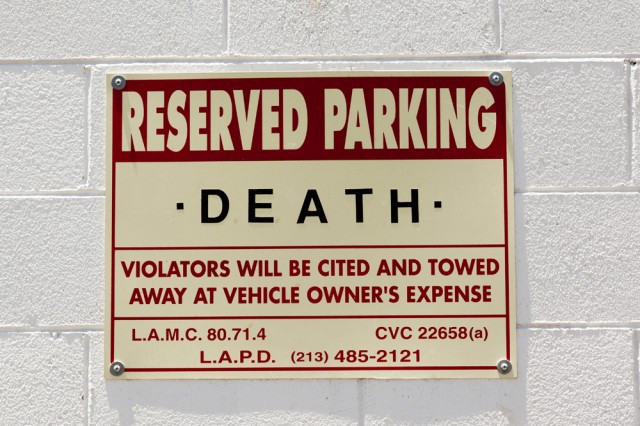
Everyone is happy at the Museum of Death.
That’s the first thing you notice if you wander in off Hollywood Boulevard on a Sunday morning, as I recently did. The owners are cracking open Heinekens. A young couple is holding hands and telling each other necrophilia “dad jokes.” A goth girl who’s sweating slightly in her outfit — a black leather bikini top over a white knitted sweater — laughs at the entryway photograph of a motorcycle accident, in which the rider’s body has been pulled in such a way that he resembles Stretch Armstrong. The picture is a test for potential visitors to see if they have the stomach to enter, and she most certainly does.
It’s not what I thought I’d encounter at all. You’d expect the Museum of Death to be a real downer, right? And in a way it is. Photos of a naked woman playing with the head of her recently murdered boyfriend, a video of a man being embalmed, and the mummified head of a serial killer all sent pangs through my gut, but the owners’ belief that confronting death allows you to “live your best life” — as they tell every customer that exits — pervades as much as the darker factors.
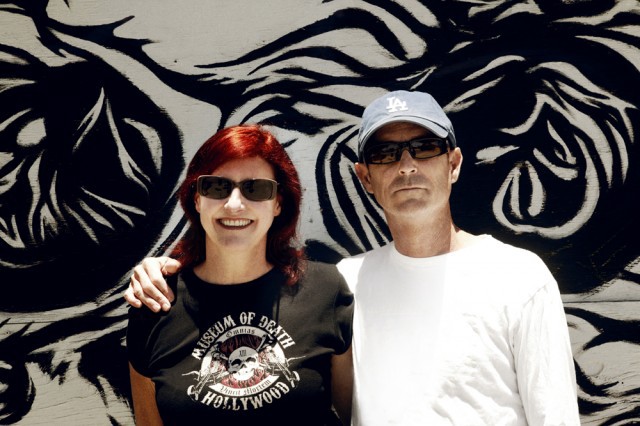
Founded in 1995, the museum was originally housed in a “haunted” ex-mortuary in San Diego, but a few years ago, owners Cathee and J.D. (who prefer to go by just their first names), packed up everything they owned — including their pet pig “Chaos,” who once ran for Republican presidential nominee (“he wore an Abe Lincoln-type hat and would walk down the main drag of San Diego,” says Cathee. “His platform was ‘Food for All’”) — and moved to Los Angeles. Chaos, who was dead at the time of the move, currently stands stuffed in the museum’s movie theater, which plays the movie Traces of Death on repeat.
The museum wasn’t exactly Sunday School, but between seeing an abstract painting by Charles Manson, clothing that members of Heaven’s Gate wore when they drank the deathly Kool-Aid, and “muderabillia” — including one serial killer’s sexy pinwheels, which were made from illegally imported tapes and often featured a woman being penetrated from behind or performing fellatio (the artist explained his work in a letter, writing, “The subject matter is sexual because I’ve been locked up in a cell for so many years without sex. It is about being horny and missing woman”) — I did learn a few valuable life lessons.
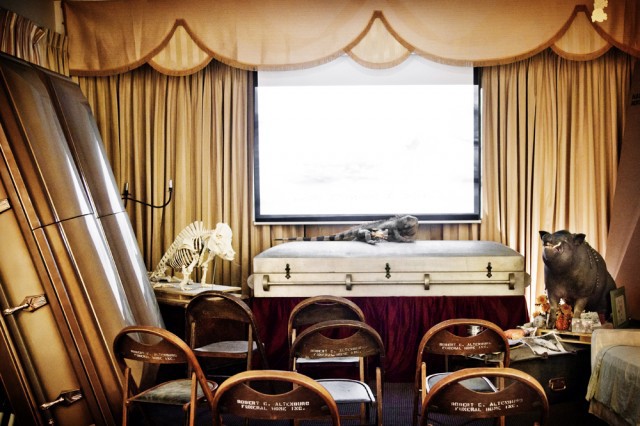
The best decisions are sometimes made while projectile vomiting.
“We met in Scottsdale, Arizona, in 1983 and we got married two weeks later,” Cathee tells me. Who proposed? I ask because I’m recently engaged and wedding-obsessed. J.D. pops open a beer and says, from behind the counter and with an ironic smile, “Who remembers?”
But the short story is that Cathee and J.D. met at a bar, spent all night drinking, and in the morning tried to board a plane to Las Vegas so they could tie the knot right away. Unfortunately they were projectile vomiting so much that that they weren’t allowed on the plane, and had to wait two weeks to be married by a Justice of the Peace in Phoenix. They’re still together nearly 20 years later.
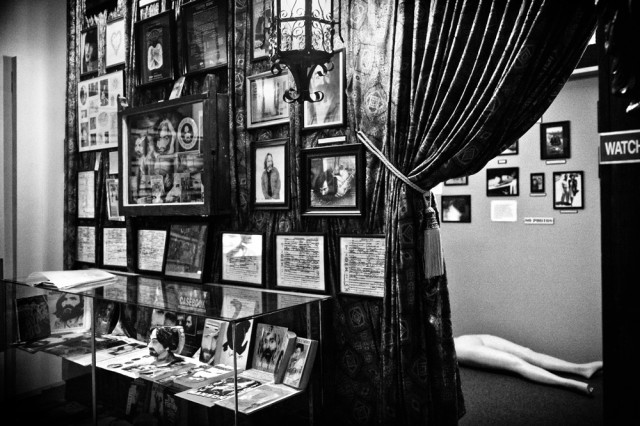
First thing, you’ll need is a good figurehead.
Cathee and J.D. first migrated to Hollywood to start a punk band, but after buying instruments and never really playing them, they decided to settle down in San Diego. There they moved into the old mortuary and started a gallery. Not wanting the weight of a potentially controversial gallery to be solely on their shoulders, and as an emulation/tribute to many of the big art galleries of the ’80s that were owned by women, they created a fictional figurehead, Rita Dean, and named the gallery after her. So when police came to shut down a particularly raucous opening or tried to charge them with pornography for posting a giant photograph of a large naked woman in the window, Cathee and J.D. would tell the police they’d be sure to let their boss, Miss Rita Dean, know. “It was always funny when someone would earnestly tell us how close they were to Rita,” laughs Cathee.
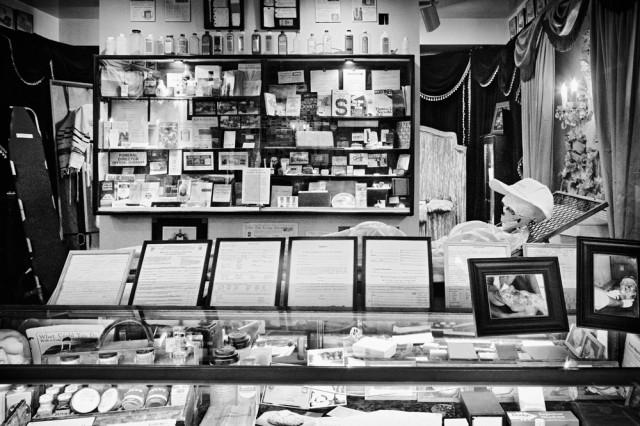
Next step, become a museum, not a gallery.
The gallery quickly gained a reputation for hosting wild art exhibitions, including everything from sex shows held in the mortuary to a piece of art made from 1,000 hits of acid. But, it was “Cereal Killers: The Art of Corporate Lebensraum,” an art show in which J.D. juxtaposed serial killers with cereal boxes, that proved to be one of their most popular exhibitions both in terms of attendance and reviews. “We started investigating serial killers specifically,” says J.D. “We were writing to these people to try to figure out who they were.”
But sex and death weren’t everyone’s favorite topics. In one case, and after multiple run-ins with the local police, Cathee and J.D. enlisted the ACLU to help protect their right to display large photos of naked women. This was roughly when the Contemporary Arts Center of Cincinnati was being sued for displaying a risque Robert Mapplethorpe photograph. “We were going through a very similar thing, so I called them to see what happened,” says Cathee. “And they said that as long as you have the word ‘museum’ in the title of your business, then nobody really fucks with you.” The opposite is true, she says, “if it says ‘art gallery,’ ‘center,’ or ‘institute.’”
“Because all the places funded by the government are called museums,” interjects J.D.
“So they don’t mess with them. We decided, wow, we do so many controversial things, let’s call it a museum,” Cathee continues. Once they changed the name, the authorities left them alone.
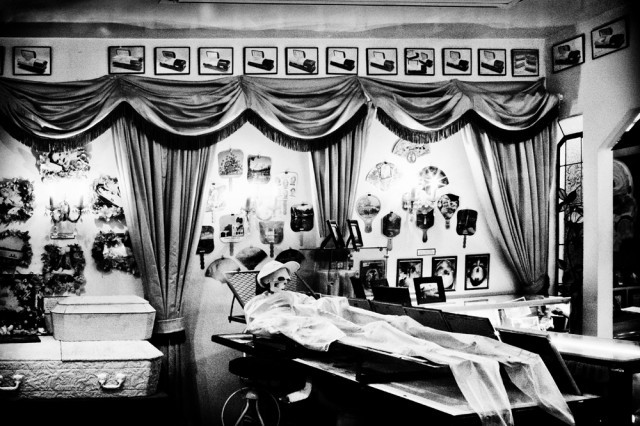
If you build it, dead stuff will come.
“When we opened the Museum of Death in San Diego, honestly, it was kind of a prank,” Cathee recalls. “It was an installation for art. It was really just this thing that we created and put the title ‘museum’ on.”
“Once it said Museum of Death on that sign, we became a magnet,” says J.D. “That’s how our collection grew, by having the sign out and letting people know we were interested in things.”
“Right away you get a coffin. Everyone gives you coffins,” says Cathee.
Apparently they also give you hearses, the first of which, in the Museum of Death’s case, was parked behind the building and promptly stolen. Or sometimes dead men’s hands just show up on your doorstep. (The hand, addressed to J.D. from “a friend who is really cool and in the position to give it to us” made Cathee jealous. To make it up to her, the same friend brought Cathee a baby fetal hand to be worn as a nose ring. “But I couldn’t wear it much, because the little baby hand would go up my nose and feel like it was picking it,” Cathee says.)
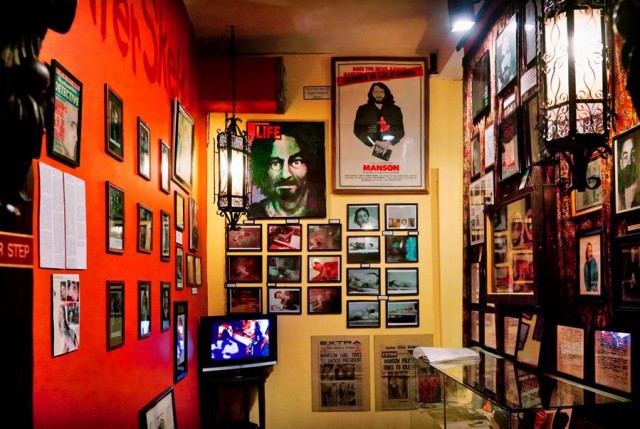
Everyone likes a good postcard.
“It’s always a great day to look in your mailbox and get a letter from Charles Manson,” J.D. tells me. He’s been writing to serial killers since the “Cereal” exhibition, and the museum had been slowly growing a collection of letters when he asked a friend who had Manson’s address to share it with him. “My friend wrote to Manson for three years before Manson replied to a single letter,” J.D. says. “He told me, ‘Manson’s never going to write you,’ but I was like, ‘just give me his address,’ so he finally did. Months later, Cathee and I were driving through the desert, and we found a killer postcard of a scorpion at a truck-stop. So, we wrote on it ‘Just thought you’d like this’ and our address and sent it to Manson. A week later we got a reply.”
And what did Manson’s first letter look like? “It was a postcard that just said ‘Thank you for the postcard.’”
Since then, the owners have corresponded with Manson so many times that the museum has an entire room dedicated to him.
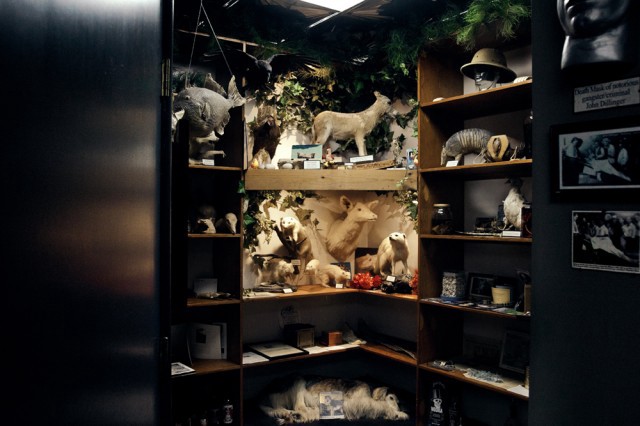
Chickens with two assholes are mean drunks.
Animals die, too. And so, unsurprisingly, the Museum of Death features a “Specimen Room” dedicated to taxidermy. Although the room vaguely reminded me of basement dens belonging to men I knew growing up in the Midwest, it also had a distinctly twisted feel, likely because Cathee and J.D. used to own a “Freak Farm.” (They still own a two-headed turtle that lives in a glass tank in front of the museum.) So instead of simple deer heads, specimens like a chicken with two anuses are proudly displayed. “She was a beer-guzzling bird,” Cathee says. “She used to sit with us on the counter until the end of the night. We all had Heinekens, and we’d leave one on the counter and she would guzzle it right up. She was a mean drunk. People would come over and want to pet her, and I’d tell them ‘I wouldn’t pet her right now, she’s kind of drunk.’ But they’d pet her anyway, and sure enough she would peck them.”
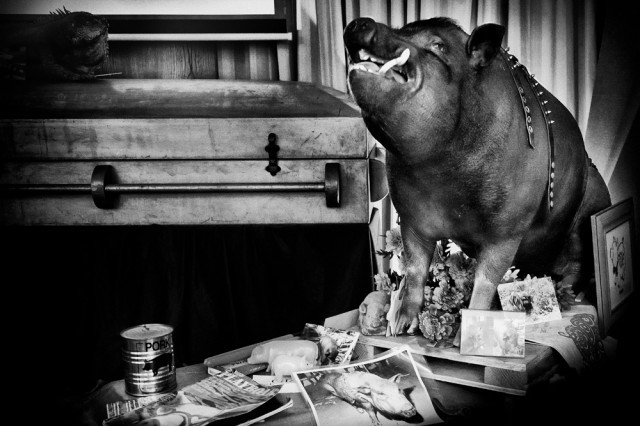
Ghosts can be good things…
Though J.D. and Cathee love their new building in Los Angeles, the one thing they’re sad about is that nobody has died in it. The building does have some history, though: it was once a recording studio called the Mastering Lab, where Pink Floyd recorded The Wall and Fleetwood Mac recorded some of Rumours, but in San Diego their museum was apparently also home to ghosts.
“After we left the building, they decided to expand it,” Cathee says. “So they evacuated the basement, where we used to have the museum, and found 125 bodies right there under the concrete where we worked. See, the mortuary was contracted in 1894 as a place to bury the indigent dead in San Diego for ten dollars a body. They were supposed to put the dead in the cemetery, but they clearly didn’t. So, anyway, there are no ghosts here, and we wish there were.”
Except when they try to get inside you.
“I had a ghost try to get into me,” J.D. says. “Freaks me out. It was at the first museum. When I was sleeping, this thing tried to get into me.”
“It was crazy. I’m lying next to him and I hear him gurgling,” Cathee says.
“I sit up and I can’t talk or anything.”
“I’m like dude, you’re having a nightmare, wake up!”
“I’m shaking her and she smacked me. And, I’m like, ‘oh my god, E.W. — the ghost that lives in the mortuary — tried to get into me.’ She’s like, ‘BS, you’re dreaming. Go to sleep.’ The next day we wake up and this girl who lives above us said the same thing happened to her that night!”
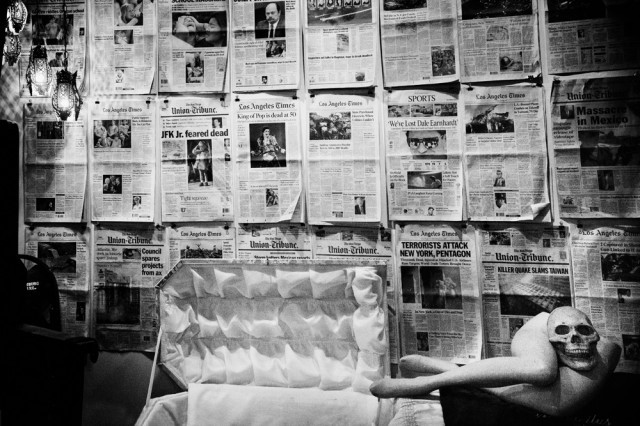
Don’t steal from the Museum of Death.
Not many people steal from the Museum of Death. Which is partially because every room is equipped with a surveillance camera, and partially because it’s probably really bad luck to decorate your studio apartment with a stolen painting by John Wayne Gacy. But the famed “motorcycle accident” test photograph was once stolen, although even then the guy ended up bringing it back. “It wasn’t drilled down or anything,” explains Cathee. “We found out after the fact. One day it was just gone. And about three months later it showed back up, perched inside a coffin. A friend of the person who stole it later told us that the night he stole it, the guy got into a really bad car accident. He lost his job the next day, and bad stuff like that started happening from the moment he took it. Bad. Bad. Bad. After a while all his friends convinced him to bring the photo back.” Once returned, the photo regained its current place as the “tester” to see if visitors can handle the museum.
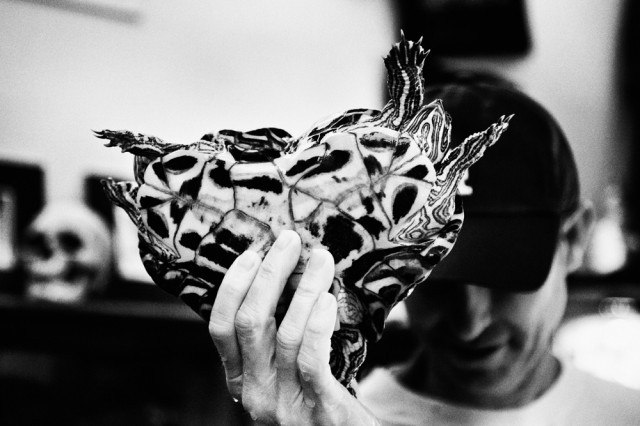
Finally, if you have just arrived from China and speak little to no English, (don’t?) go straight to the Museum of Death.
While I’m interviewing Cathee and J.D., two young Asian women enter the museum. They speak only a tiny bit of English, so it’s with much gesturing and confusion that they finally communicate that is their first stop after arriving in Los Angeles from China. J.D. shows the girls the motorcycle photograph, and they squeal in disgust, one looking as if she might faint. Deciding that the Museum of Death might not be the best fit for them, J.D. suggests they meet his pet Siamese turtle instead. The girls agree, eagerly take photos of the two tiny heads poking out of the turtle’s shell, thank him, and exit. That two-headed turtle is their first snapshot of America.
Previously: Last Song in Death Valley Junction.
Maude Standish is a trend forecaster by day and a freelance writer by night. She blogs at jerkbabies.tumblr.com.
Jennie Ross is a freelance photographer who documents adventures when and wherever possible. She received her BFA from NYU’s Tisch School of the Arts and currently lives in Los Angeles.